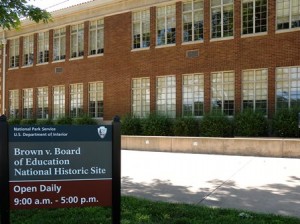Archive for June 3rd, 2013
» posted on Monday, June 3rd, 2013 by Linda Lou Burton
Brown v Board
 Linda Burton posting from Topeka, Kansas – “We conclude that in the field of public education the doctrine of ‘separate but equal’ has no place.” Such was the opinion written by Chief Justice Earl Warren in the 1954 Supreme Court Decision Brown v Board of Education. In a former schoolhouse on a side street in downtown Topeka, you can walk through a history of events that led up to that landmark decision, and what has happened since. The building, now a National Historic Site, once served as Monroe Elementary, and it still has a schoolhouse feel; in the hallway you pass drinking fountains set low enough for a kindergartner to reach;
Linda Burton posting from Topeka, Kansas – “We conclude that in the field of public education the doctrine of ‘separate but equal’ has no place.” Such was the opinion written by Chief Justice Earl Warren in the 1954 Supreme Court Decision Brown v Board of Education. In a former schoolhouse on a side street in downtown Topeka, you can walk through a history of events that led up to that landmark decision, and what has happened since. The building, now a National Historic Site, once served as Monroe Elementary, and it still has a schoolhouse feel; in the hallway you pass drinking fountains set low enough for a kindergartner to reach;  there’s the smell of chalk, and echoes in the hall. Monroe Elementary was one of four all-black elementary schools in Topeka when it was selected by NAACP strategists in 1950 as part of a larger plan to bring the “separate but equal” doctrine into the courts. With NAACP guidance thirteen sets of parents agreed to attempt to enroll their children in white schools, not expecting to be admitted, and then file complaints. Linda Brown (b 1942) was a third grader at Monroe at the time her
there’s the smell of chalk, and echoes in the hall. Monroe Elementary was one of four all-black elementary schools in Topeka when it was selected by NAACP strategists in 1950 as part of a larger plan to bring the “separate but equal” doctrine into the courts. With NAACP guidance thirteen sets of parents agreed to attempt to enroll their children in white schools, not expecting to be admitted, and then file complaints. Linda Brown (b 1942) was a third grader at Monroe at the time her  parents Leola and Oliver Brown decided to participate; alphabetically “Brown” was the first name on the lawsuit; forever after Brown v Board of Education is the name associated with the end of public school segregation in the United States. The full story, however, is multi-layered and complex; the exhibits in the Brown v Board of Education National Historic Site take you through the key points, even going further back in time than the 1896 Supreme Court decision when Plessy v Ferguson put the “separate but equal” doctrine legally into place. Race and the American Creed is the place to start; it’s a movie in the auditorium. » read more
parents Leola and Oliver Brown decided to participate; alphabetically “Brown” was the first name on the lawsuit; forever after Brown v Board of Education is the name associated with the end of public school segregation in the United States. The full story, however, is multi-layered and complex; the exhibits in the Brown v Board of Education National Historic Site take you through the key points, even going further back in time than the 1896 Supreme Court decision when Plessy v Ferguson put the “separate but equal” doctrine legally into place. Race and the American Creed is the place to start; it’s a movie in the auditorium. » read more
